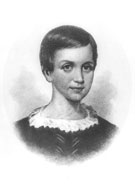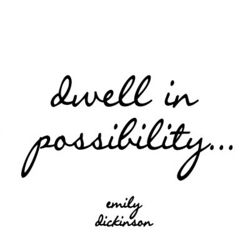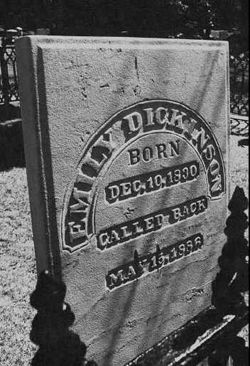User:Renmax04
From 1850s
Contents |
[edit] Emily Dickinson's Biography
[edit] Early Years
In 1830 Amherst was a small farming town, but later became a center for schools and universities, a town which was known to be highly educated. Emily Dickinson was born on December 10, 1830 to Emily and Edward Dickinson. Emily had a brother, Austin, who was a year and a half older, and a sister Lavinia was two years younger. Some scholars argue that her mother made her child life difficult because she was emotionally detached from her daughter, something that Emily missed dearly in her life. Her mother would spend very little time with her daughter, and where noted seems that when they were together, it was not the easiest of times. In the beginning of April of 1840, the Dickinsons bought a house for $3,000 where they had a whole house and two acres of land. Her brother who was only fifteen months older than her and in her poetry when there was a "boy" reference, it is believed to be Austin himself.
In the fall of 1840, when she was nine years old, Emily Dickinson was one of the first girls to attend the previously all-male Amherst Academy. Although she went to school there for seven years, they were both hard and sporadic. She studied Latin, geology, biology, algebra and church history. At the young age she was considered "very bright" and was praised by one teacher of hers in particular, Daniel T. Fiske. At the age of seventeen Emily left for South Hadley, Massachusetts to attend the Mount Holyoke Female Seminary. This time proved to be a difficult one for her because of of her lack of faith in Christ and was only there for less than a year. Some also believe she could have also returned because of health reasons but it was after her time at the Seminary when she returned home and began to write poetry.
[edit] Active Poet Years
At the age of eighteen, the Dickinsons befriended Benjamin Franklin Newton, who scholars believe got Emily Dickinson interested in writing short stories and poetry. In her later poetry she refers to him as a tutor and mentor. She explains in her work that Newton worked closely with her father before heading off to Worcester to study. It is believed that he introduced her to William Wordsworth's work and Ralph Waldo Emerson's first book of poetry. Dickinson held a lot of respect for Newton because of his strong faith in the new poet. He wrote to her to ask of what kind of work she was keeping busy with, making sure she was content with her writing, while wishing her success.
Emily Dickinson knew only eleven of her thousands of poems to be published during her lifetime. Even while Dickinson was alive, there were certain publications of her work that were sent to publishers, which the publishers would receive from friends and family she wrote to. This very work that was sent to publishers was something she knew nothing about, nor ever gave consent to. When her poetry was first published, they were titled, often taking away from the meaning of what Dickinson was getting at. In The Springfield Republican one of her poems was given the title "The Snake" where Dickinson was quoted as saying once given a name the poem was "defeated". In her poetry, she had no fear in questioning her Calvinist family, while questioning her own religious beliefs. Her poetry shies away from romantic ideas, but rather looking at ideas and philosophies that she had to put down on paper. Her ideas often questioned the human condition from the prospective of a hermit, hiding from society.
As she grew older, Dickinson became so secluded in her room, that she would rarely go outside to speak with friends and family, and was known for not seeing anyone during the last fifteen years of her life. Emily Dickinson's strongest contact was with Susan Gilbert who she admired tremendously. Gilbert and Dickinson were in such frequent contact, there are some three-hundred letters and poems that Dickinson wrote to Guilbert and through this frequent contact, she longed for Gilbert's approval in her work.
[edit] Later Years
Emily Dickinson signed some of her poems as "Emilie" instead of "Emily" because she wanted to clearly distinguish herself from her mother. She and her mother were never very close and it wasn't until her mother's death in November of 1882 that she was more outspoken about how poor of a job at parenting she thought her mother did: "We were never intimate ... while she was our Mother – but Mines in the same Ground meet by tunneling and when she became our Child, the Affection came."
When Dickinson's life came closer to an end she wrote: "The Dyings have been too deep for me, and before I could raise my Heart from one, another has come." Her last few letters were sent to Louise and Frances Norcross, cousins of hers, to say a final goodbye. Emily Dickinson passed away at the age of fifty-five. Her doctor noted she died of Bright's disease, which she had for a little more than two years. By the end of her life Dickinson had written almost two thousand poems, which after her death, were all sewed neatly into pamphlets which were models of freedom of thought and technique.
Among Walt Whitman and Henry David Thoreau, Emily Dickinson is considered one of the most original 19th Century American poets. She is noted for her unconventional broken rhyming meter and use of dashes and random capitalization as well as her creative use of metaphor and overall innovative style.
[edit] Bibliography
Kirk, Connie A. Emily Dickinson. Westport, CT: Greenwood P, 2004.
Habegger, Alfred. My Wars are Laid Away in Books: The Life of Emily Dickinson. New York: Modern Library, 2002.
Sewall, Richard B. The Life of Emily Dickinson. Cambridge, MA: Harvard UP, 1994.
http://www.online-literature.com/dickinson
http://www.americanpoems.com/poets/emilydickinson



